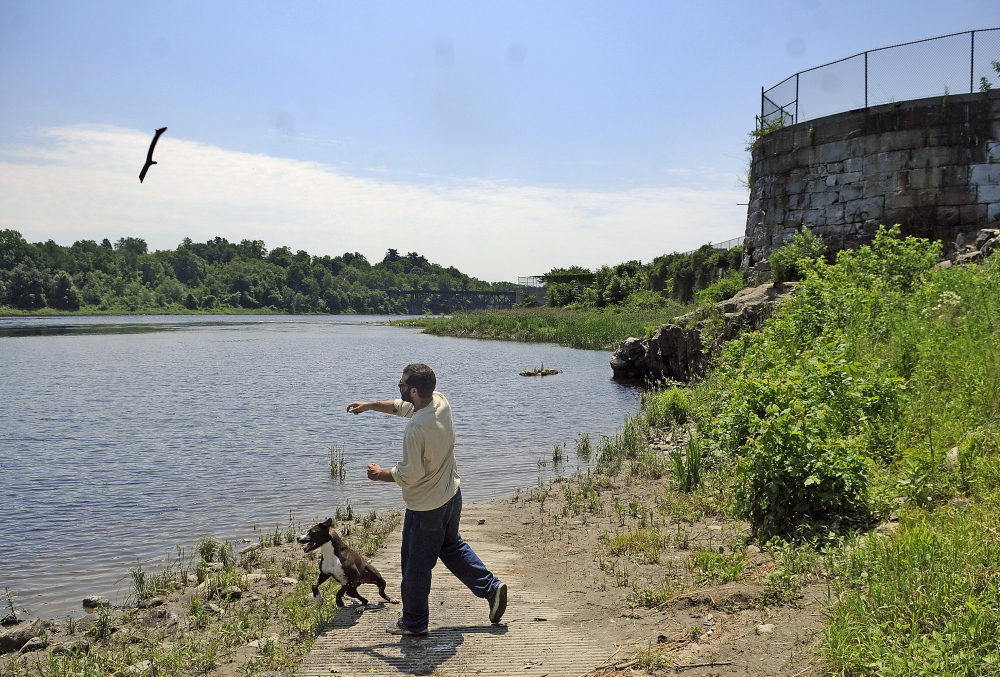AUGUSTA — The first water to flow through when Edwards Dam was breached 15 years ago was brown and thick with mud from the earthen cofferdam.
Environmental and fisheries advocates say the Kennebec River has been looking better and getting healthier ever since the 917-foot-long dam was removed on July 1, 1999, returning 17 miles of upstream water to free-flowing after they were blocked by the dam for the previous 172 years.
With the removal of Fort Halifax Dam in Winslow in 2008, the Kennebec now has the largest run of alewives and river herring on the eastern seaboard, according to the Natural Resources Council of Maine.
More shad have also been seen on the river north of Augusta since the dam removal, too.
While some other species of fish haven’t enjoyed the same strong comeback on the Kennebec – smelt fishermen reported this past season to be among their worst ever, striped bass populations remain low compared to previous years, and the rare Atlantic salmon remain rare – the alewives and other species are breathing new life into the river.
Edwards Dam was the first, and so far only, hydro-electric dam ordered removed by the Federal Energy Regulatory Commission against the wishes of its owner, and the ground-breaking event made worldwide news when it occurred.
It was controversial too, with the city of Augusta initially opposing removal.
In April 1998, Augusta City Manager William Bridgeo hosted then-Gov. Angus King at an Augusta City Council meeting at which the governor urged the city to drop its opposition to the dam’s removal. The city opposed the removal of the dam but later joined the state, the dam’s owners Edwards Manufacturing, and environmental and fisheries groups to negotiate a complex deal that headed off an anticipated court battle.
FERC then ordered it removed, denying the request for it to be relicensed.
The city initially opposed removal in part because it meant lost revenue for the city, about $250,000 a year, between property taxes and royalties from the sale of the electricity it produced as a co-licensee of the dam.
Environmentalists say the removal of the dam that produced relatively little electricity has been a boon to wildlife.
Nick Bennett, staff scientist for the Natural Resources Council of Maine, said Department of Inland Fisheries and Wildlife officials counted 58 bald eagles on a single day, June 6, along the five-mile stretch of the Sebasticook River from where it enters the Kennebec to the Benton Falls fish lift.
“That’s the largest congregation of eagles, in such a small area, likely the largest congregation on the East Coast,” Bennett said. “They’re feasting on the alewives. And we know that alewives are critical food for cod, seals and the entire marine food chain.”
Jeff Reardon, Maine Brook Trout Project director for Trout Unlimited, described the river as “dramatically different” since the dam’s removal.
“The key question is did we get what we wanted?” he said. “And, from the sections of the river with 100 percent restored access, we have seen the recovery of all the species we’d expect to see.”
Reardon said in May and June, when alewives are returning from the sea to swim up the Kennebec and its tributaries to spawn, the waters will be, literally, full of fish.
“As somebody who spends a fair amount of time on the river, it’s dramatically different now,” Reardon said. “The river is full of fish. It’s an amazing spectacle if you are in the right place, at the right time. You can tell when they’re here, because you’ll see the ospreys,” feeding on them.
As of June 22, state Department of Marine Resources workers had counted 2.37 million alewives at Benton Falls and 90,300 at Lockwood Dam in Waterville. Bennett noted that doesn’t include numerous alewives harvested below the Benton Falls fish lift, or fish that swim into freshwater ponds below Waterville on tributaries without being counted.
The wildlife benefits tilted the scales toward removing the dam in 1999. The negotiated agreement included state grant money to help restore Mill Park at the former dam site, creation of a riverfront improvement district, and payments from the state to help fund the restoration of the former city hall into senior housing.
Bridgeo said the biggest benefit to the city, however, was an improvement of previously contentious relations with state government. And to the river itself.
“It has been good for the health of the river and, I think when you look at it from a macro perspective, it has been good for the health of Maine,” Bridgeo said.
Sea-run fish returned to spawn above Edwards Dam shortly after it was removed.
Reardon and Bennett said an active and growing shad fishery has developed, as the stretch of previously blocked river has proven to be excellent habitat.
Reardon and Bennett noted shad numbers above Lockwood Dam are disappointing, and suggested fish need better access than is provided at the dam, where fish are trapped, counted and trucked upstream.
Bennett said water quality has improved between Waterville and Augusta since the dam was removed. The flowing water, he said, contains more oxygen which allows fish, insects, and other aquatic life, to thrive.
“For more than 160 years, fish coming up the Kennebec could not get past the Edwards Dam, where they were dozens of miles away from their prime spawning habitat,” Natural Resources Council of Maine Executive Director Lisa Pohlman said in a news release. “But now alewives and other fish can swim from the sea to freshwater lakes in the Sebasticook watershed, and the results have been astounding. While there is still important work to do to further improve the fisheries of the river, we now know that nature will restore itself dramatically if we give it a chance.”
Send questions/comments to the editors.




